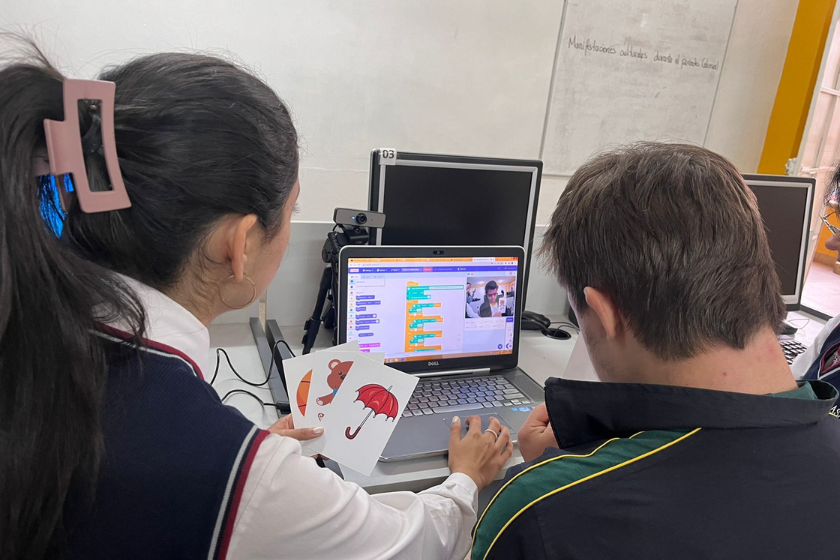Digital games can be a valuable learning tool for people diagnosed with Down syndrome, Asperger’s, Autism and Attention Deficit Hyperactivity Disorder, among others. And this was what was confirmed by the team at the Fiscomisional Calasanz Educational Unit, in Ecuador, one of the finalists of the 10th edition of Solve for Tomorrow – Central America and the Caribbean region, which brings together 11 countries: Barbados, Belize, Costa Rica, Ecuador, El Salvador, Guatemala, Honduras, Nicaragua, Panama, Dominican Republic and Venezuela.
The group of five teenagers aged 15 and 16 was selected for their prominence in the development of games and availability of time. Together with the mediator teacher Angel Songor, they created the games from start to finish, using free programming resources and tested them with approximately 10 students with learning difficulties. The team is in the first year of high school, a stage that, in Ecuador, includes three years of compulsory schooling after basic general education. Students complete three levels of general training and interdisciplinary and specialized preparation, which allows them to access higher education, the world of work and develop an entrepreneurial spirit.

The educator is a programming, thinking development and computer teacher. In his classes, the young people already had the exercise of making games using Scratch, a free and well-known programming language, because it has an online community for interactive stories, games and animations. From that moment on, the goal was to have creations based on traditional Latin American games, such as “blind hen”, which originally is played when a person is chosen to be the “hen” and blindfolded, goes out in search of a player to catch. Then it will have to recognize its “prey” only through touch. If it discovers its identity, that person will be the new “blind hen”.
In the digital version created by the students, the player uses the keyboard keys (left, right, up and down) to guide the character towards the target. The educational objective in this case is to enrich vocabulary and learn about directions. The teacher remembers that the students proposed that the games could be used with younger students or with learning difficulties.
“Blind hen” was one of the games presented to Joaquín, a 17-year-old student with Down Syndrome. The results were very positive. “He was learning to differentiate right and left but with a written format, which was complex for him. After being introduced to the game, he automatically changed his perception of it”, says Songor.

In addition to helping students, the use of this resource supports the work of teachers. “The Ecuadorian Education regime aims to include students, regardless of their condition, within the classroom. That is, not to exclude them. However, this poses a great challenge because the teacher has difficulty taking care of the regular group and students with learning difficulties at the same time,” he explains. In this way, games reduce disparities with less time.
The team had important support from the school’s Student Counseling Department (DECE), which is the body responsible for the comprehensive care of students. Its purpose is to provide psychological, psychoeducational, emotional and social support and accompaniment. “Joaquín’s mother also helped us a lot. She was telling us more or less the evaluations that she already had in other institutions and based on the student’s learning, we were verifying how we could improve,” says Songor. Basic general education teachers were also allies, sharing their experience of working with a more simplified language.
In the end, they were left with a collection of approximately 18 games, also using augmented reality and artificial intelligence to improve the playability as in a game in which the objective is for the cat to reach the mouse and the player to be able to move it with their own hand in front of his device’s camera that the platform can identify. Next, they decided to create a website to make those resources available for free. “As we progressed in the project, the Solve for Tomorrow mentors gave us these strategies to improve,” he highlights.
Knowledge shared beyond school wall
Anyone can access and play at jtdsinbarreras.squarespace.com. On the page, it is possible to filter by students profiles (Down Syndrome, Autism, Asperger’s and Attention Deficit Hyperactivity Disorder). In addition, there is information for parents and teachers on how to use the tools and a space for them to contact the team and make suggestions. Now the next goal is to upload this domain to the school’s institutional page so that the project continues to function from this sector. “We propose it this way so that it can be shared and done on a large scale; and so other schools can take advantage of this experience, take it as an example and develop their own games,” says the professor.
I have seen a lot of confidence and self-esteem among the students. There is already an attitude of facing life and challenges. In class, they are given complicated exercises and no one limits themselves. I see that it has influenced them to realize that there are no limits and they want to go beyond them, the teacher observes.
According to Songor, after the experience in Solve for Tomorrow, the students have shown greater confidence in themselves and are already thinking of trying again for the award in the next edition. In addition, this positive behavior is repeated in the classroom and they are easier to face challenges. “We are very grateful not only for the mentors of this edition, but also those of the previous one. They were always worried and giving us advice that made a difference”, he says.




